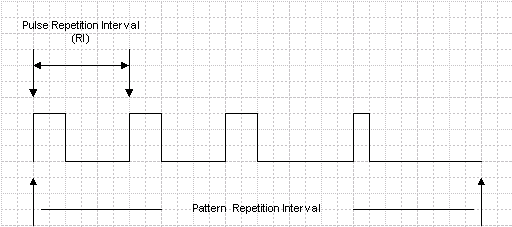
The Repetition Interval indicates the time duration of the object before the next object. It also indicates the minimum time required before a pulse or pattern, can be repeated. The Repetition Interval must be equal to or greater then the Object Length.
The Repetition Interval is measured from the first point of the object to the last point of the object and includes off time. For example, if the item type is a pattern, the Repetition Interval is the time from the first point on the first pulse to the last point of the last pulse's off time. Specifically, the Repetition Interval is:
The distance, in time, from the first point of the object to the first point of the next object. Note that the next object may be the same if the repeat parameter for the object is greater than 1 or the next pattern item is the same object name.
For Object Types and , Repetition Interval is an entry field (units are time) specifying the time interval at which the object can be repeated. The pulse or pattern starts at the beginning of the repetition interval. Time that is not consumed by a pulse or pattern signal (Repetition Interval – Object Length) is filled with zeros.
For Object Type , this field is blank.
Units used are:
s - seconds
ms - milliseconds
us - microseconds
ns - nanoseconds
The following diagram shows the repetition interval definitions. Note that the off time following the last pulse in the pattern is included as part of the pattern repetition interval.

The repetition interval property is coupled to the PRI pattern property PRI Start. When a PRI pattern is specified the actual time between objects can change and may not equal the repetition interval.